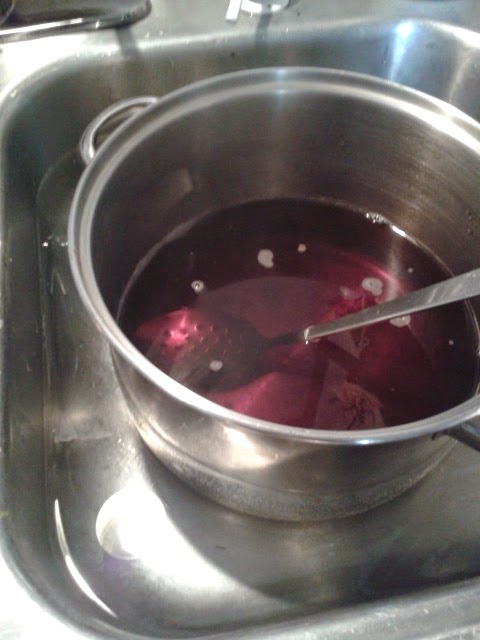You will need:
- one ounce licorice root
- one ounce marshmallow root
- one ounce slippery elm bark
- one ounce flaxseed
- 4 pints of water
- one pound of all natural raw honey or a pint of molasses
- a half gallon jar
- a small pot
- a large pot
- a mesh bag or cheese cloth
- four 14 ounce dark bottles with lids or corks (I used old Kombucha bottles)
- labels
You will start by adding the one ounce of licorice root to the small pot with one pint of water. Heat it on medium high until it boils, be careful, it foams and will quickly overflow from the pot if you don't turn the heat down to medium low as soon as it boils. Let it sit and simmer down about 30 minutes, reducing the liquid about 1/4.
While that is cooking, add the rest of the herbs into your gallon jar and pour 3 pints of hot water in. I tried putting the herbs in my handy infusion strainer but, the slippery elm has it's own pectin in it and gels up, making it hard to strain through. I found just pouring all the herbs in works better.
A little about the herbs. Licorice Root is known for its expectorant properties for use with upper respiratory infections and bronchial catarrhs. The extracts have shown anti-bacterial and anti-fungal properties. Marshmallow is an effective demulcent that coats the throat and has anti-inflammatory properties. Slippery elm will not only treat inflamed mucus membranes of the bronchial tubes, but it will absorb excess mucous from respiratory conditions. Flaxseed is also a demulcent that helps to lubricate mucus membranes and sooth inflammation.
Ok, so now that your decoction is ready, you will pour the liquid through your strainer, into the half
gallon jar so it can infuse with the other herbs for 20-30 minutes. Notice how the herbs layer while infusing? While this is happening is a great time to eat lunch or clean up your messes. Get ready because here comes the fun part.
gallon jar so it can infuse with the other herbs for 20-30 minutes. Notice how the herbs layer while infusing? While this is happening is a great time to eat lunch or clean up your messes. Get ready because here comes the fun part.
The demulcent nature of these herbs means that they are really SLIMY when they are wet. Like, forget your coffee filter, forget your infuser strainer, I ended up using those nylon reusable produce bags you get from the store in the produce section and putting that inside a large pan and pouring the whole half gallon jar into it. Wait until the infusion is warm enough to be handled, but not too cold. You will have to squeeze and milk the liquid out. Did I mention how slimy it is? It took about 10 minutes of squeezing and oozing the slime out. I usually put my spent herbs in my worm composter, but this time, I put them in the trash, I know... not very nice, but I was afraid what it would do to the worms.
 After you have successfully milked out all the liquid and disposed of the slimy leftovers, you can now pour in your honey or molasses. I changed my mind halfway through and went for the Oregon Meadowfoam raw honey at the health food store that was $9 for a pound.
After you have successfully milked out all the liquid and disposed of the slimy leftovers, you can now pour in your honey or molasses. I changed my mind halfway through and went for the Oregon Meadowfoam raw honey at the health food store that was $9 for a pound.
Once you have added the honey and stirred it all up, you can start bottling it in your brown jars. I use my tincture funnel, holding the bottle over the pot so I didn't make a mess, and using a measuring cup to scoop the very thick liquid into the jars. cork them, label them and store in a dark area or in the refrigerator.
 This cough syrup has a light sweet taste that doesn't taste like licorice. I HATE the taste of licorice, seriously, I avoid it at all costs, but this doesn't taste like that at all. You can use a tablespoon three to four times a day as needed for sore throat and cough. I am going to be using it the next few days because I am feeling like I am coming down with something. Some alternative herbs you could use in this mix would be something for immune function like elderberry or Echinacea, something to help you sleep like Skullcap, or my personal favorite all around great herb, Lemon Balm which also has antiviral, antibiotic properties and is a light sedative. For a day time cough relief potion, adding some vitamin B and C to it will help with energy.
This cough syrup has a light sweet taste that doesn't taste like licorice. I HATE the taste of licorice, seriously, I avoid it at all costs, but this doesn't taste like that at all. You can use a tablespoon three to four times a day as needed for sore throat and cough. I am going to be using it the next few days because I am feeling like I am coming down with something. Some alternative herbs you could use in this mix would be something for immune function like elderberry or Echinacea, something to help you sleep like Skullcap, or my personal favorite all around great herb, Lemon Balm which also has antiviral, antibiotic properties and is a light sedative. For a day time cough relief potion, adding some vitamin B and C to it will help with energy. 














